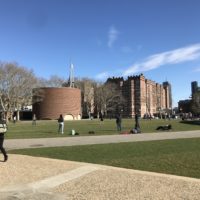Housing is a very important part of undergraduate life at MIT. You choose where you live, and each living group is a community with its own distinct culture and traditions. MIT housing is guaranteed for your entire undergraduate experience, and all first-year students live in on-campus residence halls.
We believe that students should have a great deal of freedom and responsibility in creating their lived experience, and perhaps nowhere is this principle better put into practice than in our residential life. How this works is briefly reviewed below, but you can learn more at the MIT Housing website.
Choosing where to live
All incoming first-year students are sent the MIT Guide to Residences. The Guide includes data about the residence halls (capacity, cost, etc.), as well as pictures, stories, and videos compiled by the residents about who they are and what they do for fun. Based on these factors, you develop ranked preferences about where you want to live, which you submit to MIT Housing.
All first-year students must live in MIT residence halls. However, you may socially affiliate with fraternities, sororities, and independent living groups (FSILGs). After your first year, you may want to move into FSILG housing or remain in residence halls.
During orientation, you participate in Residential Exploration (REX), where you do even more exploring of the different residence halls. If you decide you’d like to live somewhere else than where you were initially assigned, you can apply for First Year Residence Exchange (FYRE), where you can swap halls before classes begin.
Some students spend all of MIT in the first living group they picked, and some change every year. It’s up to you.
Residence halls
We have 10 residence halls in operation.01 <a href="https://mitguidetoresidences.mit.edu/residences/east-campus" target="_blank" rel="noopener">East Campus</a> residence hall is closed for a two-year renovation project and is anticipated to reopen in fall 2025. They all have different traditions, cultures, layouts, dining arrangements, and prices. Some are pristine and clean, others are full of murals and cats. It’s up to you where you choose to make your home.
Mentorship is a big part of MIT residential life. All residence halls have a live-in house team who cultivate community among their residence. These teams include faculty Heads of House and Graduate Resident Advisors (GRAs).02 Graduate students who serve as mentors to the undergraduate community by holding study breaks and providing general life advice
FSILGs
In addition to its residence halls, MIT recognizes 26 fraternities, 10 sororities, and five independent living groups, collectively known as the FSILGs. About 37% of MIT’s undergraduates are affiliated with an FSILG, and some live in FSILG housing which, with few exceptions,03 Specifically, the Kappa Alpha Theta and Pi Beta Phi sororities, as well as the Kappa Sigma fraternity residences, which are located on campus and operationally managed by MIT. are independently owned and operated by their chapters in facilities located near campus and connected by the SafeRide shuttle.
Summer housing
Students who are working or researching near MIT, as well as graduating seniors, can apply for summer housing, which is usually less expensive and more convenient than arranging for a private sublet in the area.
- East Campus residence hall is closed for a two-year renovation project and is anticipated to reopen in fall 2025. back to text ↑
- Graduate students who serve as mentors to the undergraduate community by holding study breaks and providing general life advice back to text ↑
- Specifically, the Kappa Alpha Theta and Pi Beta Phi sororities, as well as the Kappa Sigma fraternity residences, which are located on campus and operationally managed by MIT. back to text ↑




